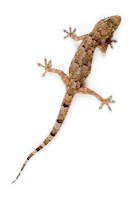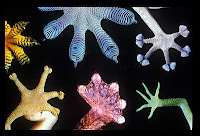 |
| Source-thesharkguys.com |
 |
| Gecko climbing the wall. (Credit: iStockphoto/Luis Carlos Torres) |
Van Der Walls Forces
At the molecular level, all molecules experience some level of attraction. This
 attraction is electrical in nature and arises from the temporary fluctuating dipoles that are created by electron motion.
attraction is electrical in nature and arises from the temporary fluctuating dipoles that are created by electron motion. A molecule that typically is symmetrical and has no electrical distortion, can exhibit an electrical charge when either a lot of its electrons happen to be in the same area of the molecule or when influenced by another molecule that is exhibiting an electrical charge. This temporary "sloshing around" of electrons creates fluctuating dipoles even in a 'normally' benign molecule.
 |
| Source-Labwater.com |
And, as one would expect, in the presence of water that exhibits a permanent dipole charge, the molecular attraction is strong, long-lived and nearly permanent.
The Underside of the Gecko's Foot
Different types of geckos have different 'looking feet' but they all share a common characteristic - they can all interact with all kinds of surfaces at the molecular level and use this molecular attraction to scamper up walls and run around on the ceiling.
 |
| Different Gecko Foot Designs Source-geckolab.lclark.edu |
 |
| Gecko Foot Hairs & Strands Source-Sciencephoto.com |
Each toe of a gecko's foot contains hundreds of pad like ridges. On each ridge are millions of hairs that each divide, at their ends, into smaller strands. These strands are so tiny that the molecules at their ends interact with the molecules of the surface the gecko is walking on. The presence of even minuscule amounts of water strengthens these attractive bonds between the gecko's strands and the surface. Maybe, this is why, the Gecko population surges after a monsoon rain when the moisture in the air makes the gecko most mobile on nearly every kind of surface.
In a laboratory environment, the Van Der Walls attraction forces between a single strand and a surface have been measured to support a weight of up to 200 microNewtons - enough to support an ant. With half a million strands on each foot a little gecko walking with 2 million strands can carry a back-pack weighing 90 lbs - the weight of a small child.
Capillary Contribution of water
Liquid bridges formed by water monolayers. between a surface and the strands under a gecko's foot, further increase the attraction bond (due to Van Der Walls forces) that enables the gecko to scamper up walls and walk on ceilings. This increase in adhesion force significantly increases with increase in surface hydrophilicity and increasing levels of humidity.
Capillary forces will be the subject of a future blog.
Capillary forces will be the subject of a future blog.
The task at hand is to use learning from a gecko's foot to use Van Der Walls forces to attract water molecules in the atmosphere using water molecules resident on a hydrophilic surface.
No comments:
Post a Comment